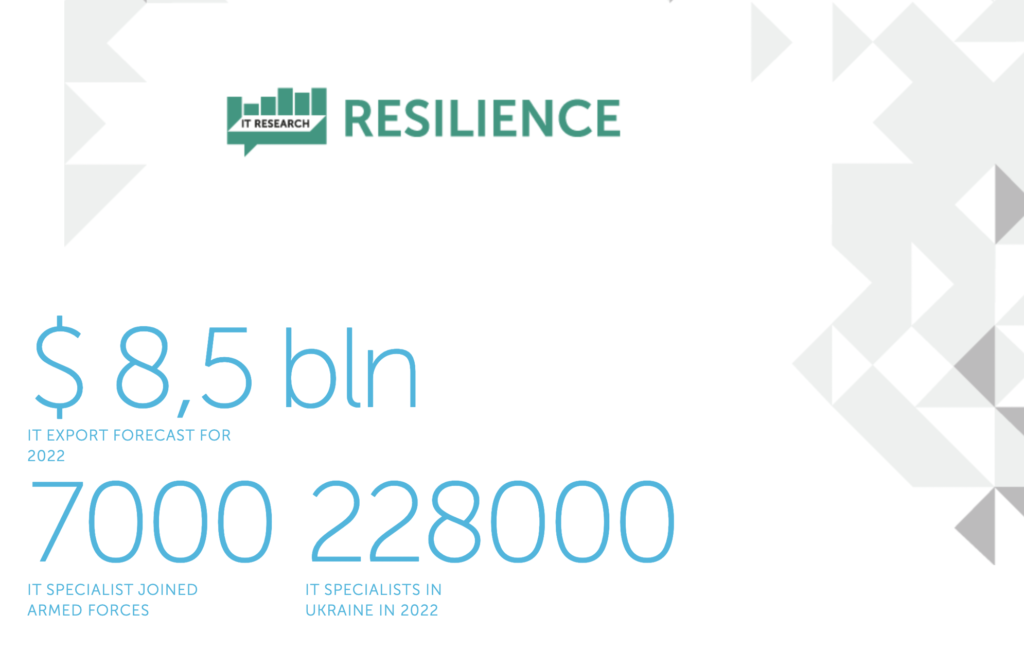On July 28, the Lviv IT Cluster presented the results of 2022 IT Research Resilience Survey: The War’s Impact on Ukraine’s IT Industry to reveal insights about critical changes in the country’s tech business activities since February 24. The report outlines the current state of the tech sector, explores how the country’s tech industry has changed since February 24, and above all, models scenarios for the future of vision.
The swiftly changing IT market landscape makes it difficult to make long-term predictions about the future, that is why we chose a holistic approach for this IT Research Resilience study on future scenarios for the development of events in the tech industry and look beyond the horizon after the victory.
The survey, fielded between May and June 2022, found Ukraine’s tech businesses navigating the path to future growth. The findings were revealed through a survey of more than 5,000 industry representatives of the IT community across Ukraine’s top regions where IT companies relocated since February 24, Lviv, Ivano-Frankivsk, Ternopil, Chernivtsi, Zakarpattia, Rivne, and Volyn regions.
How IT sector changed since the full-scale invasion
With the main tech hubs being located in Kyiv, Lviv, Kharkiv, Dnipro and Odesa, there were around 285,000 people working in tech by the end of 2021. As of June 2022, there were 60,000 fewer workers in the IT industry, down to 228,000, a nearly 21% decrease from a year earlier.
The full-scale war shook the tech industry like any other sector in the economy. At least 50,000-57,000 IT workers relocated since February 24, whilst 7,000 joined territorial defense or the armed forces. Nearly 18% of interviewed individual entrepreneurs plan to move their business abroad, according to the results of the study.
IT specialist profile: income, expenses, relocation costs
The report found that the median salary was around $2,360 since February 24, similar to the previous year. The study showed that 71% of the tech professionals were male, 29% female.
Three-quarters of respondents (73%) see their salary at the same level or increased, although the expenses have also increased slightly. The findings show 20% of their income went towards saving and 21% of their income on food. 89% of surveyed respondents said that they donated part of their income to charities.
IT specialists who relocated to western Ukraine spent about $14.7 million on household needs during the first month after their relocation, and they are spending another $13.6 million every month in the regions where they settled after February 24. If they continue to stay in these regions and spend the same amount by the end of 2022, the total amount of spending will reach $137.1 million.
Decision-making factors: stay or migrate?
For tech companies, people are their greatest asset. Therefore, IT workers’ attitude towards relocation abroad, and uncertainty in this area continues to be a major concern for the professional community. In the 2022 IT Research Resilience survey, 57% of respondents say they want to stay in Ukraine no matter what.
The survey presented respondents with three potential scenarios they might face – Positive, Neutral and Negative – which were related to the development of events in Ukraine. The positive scenario related to European integration and liberalization of the economy revealed that there was a widespread attitude towards staying in Ukraine rather than moving abroad. Among respondents, four-fifths (78%) of IT specialists prefer to stay in Ukraine, while nearly 27,000 (12%) would try to migrate abroad, in this specific context of the positive scenario.
Having described the main characteristics that distinguish between respondents, that is, planning to migrate or stay in Ukraine, this survey paints a portrait of an IT specialist who is determined to move abroad in which he/she appears to be a 34-year senior qualification specialist, often in a relationship.
In the survey, once participants had selected one of the options, they were asked whether a series of factors influenced their decision to migrate onwards. The survey report examines in greater detail the factors influencing these two main decisions. How the war in Ukraine will end, how the economic policy will be changed after the victory, alongside various individual factors, have influenced people’s plans and decisions to stay or migrate from Ukraine.
War economy: business recovery and financial outlook
According to IT Research Resilience, 85% of surveyed companies reported their organization’s business operations being recovered in May 2022, they managed to completely or almost completely continue business activities at the same level as before February 24.
In January-May 2022, the IT sector showed signs of stronger growth compared with the same period last year, according to the National Bank of Ukraine. According to the research data, if the growth continues at a steady pace, then the industry’s export revenue may reach $8.5 billion by the end of 2022. If IT specialists who relocated lose tax residency of Ukraine, the estimated export revenue may be lower at about $7.5-7.2 billion
But if approximately 10% of IT specialists cease to be tax residents of Ukraine, the estimated export revenue may be lower, at about $7.4-7.8 billion.
IT Research Resilience is a research project of the Lviv IT Cluster. It was transformed from the IT Research Ukraine project, which the Cluster announced at the beginning of 2022. Since the full-scale offensive of Russia, the project was adapted to new realia. The project was implemented in partnership with the Ministry of Digital Transformation, the USAID Program “Competitive Economy of Ukraine”, supporting small and midsize businesses and startups, and the Western NIS Enterprise Fund, which supports initiatives to promote reforms in Ukraine and transformative projects. The collection and analysis of basic data within the sociological part of the IT Research Resilience project was provided by the Fama Research Agency on the request of the Lviv IT Cluster.
For more insights, read the full report “IT Research Resilience: The War’s Impact on Ukraine’s IT Sector”

